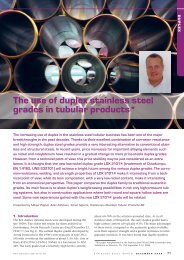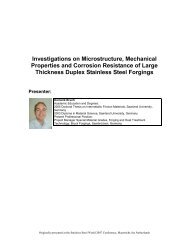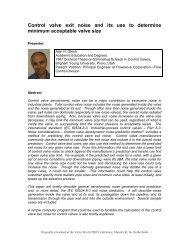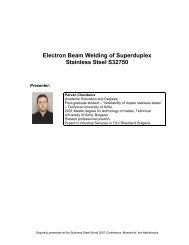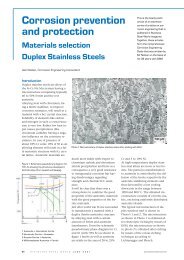Duplex stainless steel welding: best practices*
Duplex stainless steel welding: best practices*
Duplex stainless steel welding: best practices*
You also want an ePaper? Increase the reach of your titles
YUMPU automatically turns print PDFs into web optimized ePapers that Google loves.
Test Purpose Additional Details<br />
ASTM A923 Method B or C Determines if any intermetallic phases<br />
or precipitates were formed during<br />
<strong>welding</strong> process<br />
the shielding gas further support formation<br />
of austenite during cooling<br />
so that the weld and HAZ are more<br />
easily converted back to the optimal<br />
austenitic to ferritic balance. It is difficult<br />
to test the toughness in the<br />
HAZ by traditional methods since<br />
the zone is often not more than one<br />
or a few grain sizes wide 4 .<br />
DSS General Welding<br />
Guidelines<br />
Acceptable welds do not depend<br />
solely on a welder’s ability to weld<br />
DSS; it also depends on a range of<br />
variables such as base and filler<br />
material selection, pre/post-weld<br />
cleaning, joint preparation and,<br />
most importantly, choice of the most<br />
suitable <strong>welding</strong> process for a specific<br />
job. Historically, fabricators new<br />
to <strong>welding</strong> DSS spend a significant<br />
amount of time fine tuning their<br />
WPS to achieve optimal weldments.<br />
The following guidelines are intended<br />
to supplement API 938-C. The<br />
guidelines, suggest parameters for<br />
weld procedures as well as providing<br />
knowledge to create welds with excellent<br />
properties, with reasonable<br />
production, and low repair rates.<br />
Workmanship<br />
The most important factors in successfully<br />
<strong>welding</strong> DSS are quality<br />
workmanship and welder education.<br />
Rewards are significant when<br />
welders are informed and involved<br />
in the details of the weld procedure<br />
since even the <strong>best</strong> welder can create<br />
marginal welds with an excellent<br />
WPS. An informed and proactive<br />
welder can create successful, repeatable,<br />
welds when there is an understanding<br />
of the important role<br />
the variables play in achieving an<br />
optimum (α → γ) balance in DSS.<br />
Engineering<br />
The key to obtaining well balanced<br />
ferrite proportions within the basemetal,<br />
weld-metal, and HAZ is to<br />
perform Welding Procedure<br />
Specifications (WPS) and Procedure<br />
Qualification Records (PQR) that address<br />
DSS <strong>welding</strong> issues as well as<br />
all requirements and codes for weld<br />
joints and applications. According<br />
to code requirements, a WPS and<br />
PQR must meet only the minimum<br />
requirements specified in the design<br />
code. The <strong>welding</strong> of DSS demands<br />
that additional tests be conducted to<br />
Must have predetermined acceptance criteria<br />
Determine if precipitates affect corrosion resistance and mechanical<br />
properties<br />
Ferrite Readings<br />
WPS and PQR generally uses point count method<br />
(1) Point Count Method Determines % ferrite<br />
Check �–� balance for entire weldment thickness. Optimal ferrite<br />
Check content �–� between balance 35-60% for entire weldment thickness. Optimal ferrite<br />
content between 35-60%<br />
(2)Electromagnetic Measuring Determines % ferrite or FN Used during production <strong>welding</strong> to verify % ferrite in accordance with<br />
(2)Electromagnetic Method<br />
Measuring Determines % ferrite or FN Used WPS and during PQR production <strong>welding</strong> to verify % ferrite in accordance with<br />
Method<br />
WPS and PQR<br />
Sample preparation according to manufacturer’s recommendations<br />
Sample preparation according to manufacturer’s recommendations<br />
Use for WPS and PQR for comparison with production welds<br />
Use for WPS and PQR for comparison with production welds<br />
Device measurements of the weld cap and root should be within 35–<br />
Device 60% ferrite measurements content of the weld cap and root should be within 35–<br />
60% ferrite content<br />
Hardness survey Check maximum allowable hardness Depends on DSS grade and service environment<br />
Hardness survey Check maximum allowable hardness Depends on DSS grade and service environment<br />
Recommended not to exceed HV10 310<br />
Recommended not to exceed HV10 310<br />
Caution: Conversion from Vickers hardness to Rockwell for DSS is not<br />
Caution: represented Conversion by ASTMfrom E140. Vickers Refer hardness to API-938C, to Rockwell Figure for 2, for DSS hardness is not<br />
represented conversions. by ASTM E140. Refer to API-938C, Figure 2, for hardness<br />
conversions.<br />
Impact Testing Toughness measurement Typically associated with minimum design temperature and engineering<br />
Impact Testing Toughness measurement Typically recommendations associated with minimum design temperature and engineering<br />
recommendations<br />
EN specifies minimum 60J at room temperature<br />
EN specifies minimum 60J at room temperature<br />
Frequent requirements for parent and weld metal are minimum 45J<br />
Frequent average at requirements -46°C per ASTM for parent A923and Method weldB. metal The are narrow minimum HAZ45J<br />
average precludesat accurate -46°C per impact ASTM measurements A923 Methodin B. isolation. The narrow HAZ<br />
l d t i t t i i l ti<br />
Table 4: Additional details to ASME Section IX in the development of a WPS and PQR.<br />
56 S T A I N L E S S S T E E L W O R L D D E C E M B E R 2 0 0 7 www.<strong>stainless</strong>-<strong>steel</strong>-world.net<br />
<strong>Duplex</strong><br />
ensure that the weld will be suitable<br />
for the intended service and exhibit<br />
the same physical and corrosion resistant<br />
qualities as the base metal.<br />
In particular, heat inputs should be<br />
well documented in the WPS and<br />
PQR so that welders may duplicate<br />
the original during production <strong>welding</strong>.<br />
If the appropriate precautions<br />
and controls are not recognized during<br />
the WPS and PQR development<br />
stage, production welds can be<br />
plagued with problems. In addition<br />
to the requirements set forth in<br />
ASME, Section IX, or the appropriate<br />
design code for the weldment, there<br />
are a handful of additional tests and<br />
controls that should be applied to<br />
the WPS and PQR development to<br />
ensure that the welds produced are<br />
mechanically sound, corrosion resistant,<br />
and repeatable under shop<br />
or field conditions.<br />
The requirements of ASME Section<br />
IX should be addressed in the development<br />
of WPS and PQR as well as<br />
the tests listed in Table 4.<br />
Base Material Selection<br />
Base materials should be delivered<br />
in an acceptable condition since



